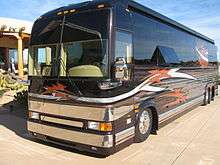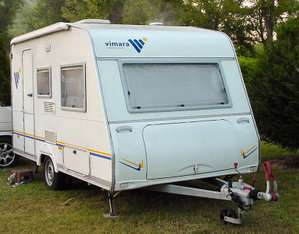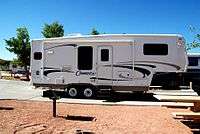List of recreational vehicles
This is a list of types of RVs from the article recreational vehicle.

Class A motorhome

Constructed on either a commercial truck chassis, a specially designed motor vehicle chassis, or a commercial bus chassis, a Class A motorhome resembles a bus in design and has a flat or vertical front end and large windows. In 1989, the addition of slideouts dramatically changed the industry because they allow a wider living area, provided that the vehicle remains completely stationary during their extension outwards.
Bus conversion
A commercial passenger bus or school bus that has been converted into an RV. Highly customized with luxury components, passenger bus conversions are typically the largest motorhomes available.
Diesel pusher
A diesel pusher motorhome is typically a Class A that is powered by a diesel engine mounted in the rear of the RV.
Advantages
- Class A motorhomes are the most luxurious and offer the most amenities.
- Slideouts offer more space
- Living quarters are easily accessible from cockpit
Disadvantages
- Their size makes them hard to maneuver
- Poor fuel economy due to their boxy shape.
- Poor safety
- Requires a special license or endorsement to be operated in some jurisdictions.
Manufacturers
Current Manufacturers
- American Coach
- Coachmen
- Entegra
- Fleetwood
- Forest River
- Foretravel
- Holiday Rambler
- Jayco
- Monaco
- Newell Coach
- Newmar
- Nexus
- Prevost
- Thor Motor Coach
- Tiffin
- Trek
- Winnebago
Defunct or Exited Segment
- Airstream
- Alfa
- Avco
- Barth
- Beaver
- Blue Bird
- Champion
- Cobra
- Country Coach
- CT Coachworks
- Damon
- Dodge
- Eldorado
- Establishment
- Eurocoach
- Executive
- Firan Motor Coach
- FMC
- Georgie Boy
- GMC
- Gulfstream Coach
- Harney
- Hawkins
- HMC
- Itasca
- Komfort
- Mallard
- MCI
- National
- Odessa
- Rexhall
- Rockwood
- Safari
- Suncrest
- Sunrader
- Travel Queen
- Travel Supreme
- Triple E
- Vega
- Vogue Motor Coach
- Western RV
Class B motorhome (campervan)

Built using a conventional van, to which either a raised roof has been added or the back replaced by a low-profile body (aka coach-built). In Australia, a Class B motorhome is quite distinct from a campervan, as it is based on a very large van that is, in turn, based on a truck. These motorhomes weigh up to 4500 kg and measure up to 6.4m in length. Popular vehicle makes include the Ford Trader and Isuzu NPR 300.
Most Australian campervans are based on much smaller vehicles such as the Toyota HiAce, while the middle ground is now populated by larger vans that blur the definition of campervan or motorhome. These include the Ford Transit, Mercedes Benz Sprinter, Fiat Ducato, and Iveco.[1]
In the United States and Canada, class B motorhomes are built on several different chassis depending on the motorhome manufacturer and engine design aims. Common chassis include the Mercedes Benz Sprinter diesel, the Dodge Ram Promaster gas, the Chevrolet Express gas, and the Ford Transit gas and diesel.
Manufacturers
Current Manufacturers for the US and Canada markets
- Airstream
- Coachmen
- Leisure Travel
- Midwest Automotive Designs
- Pleasure Way
- Roadtrek
- Sportsmobile
- Winnebago
Class B+ motorhome
A recent invention, a class B+ motorhome is a hybrid between a class B motorhome and a class C motorhome. These motorhomes are either built on a truck or van chassis. They usually include a "cab-over" section. They also include many amenities that a class C motorhome has, including a refrigerator, microwave, sofa/table, and dishwasher. The bath area is also bigger, usually not a wet bath. Although not common, some of these motorhomes include a closed bedroom. These RVs usually hold two people, yet some hold four.
Class C motorhome

A Class C motorhome is built upon a minimal truck platform with a forward engine and transmission connected by driveshaft to a rear axle that propels dual-mounted rear wheels. Class C motorhomes are typically powered by gasoline (petrol) engines, although some have been converted to run on propane (autogas) while others use diesels. Transmissions are almost always automatic. The original chassis is equipped from the truck factory to the coach builder with an attached forward cab section that is van or conventional truck based (known as a cutaway chassis). In North America, the Ford E350 or E450 chassis are the most typical in the 21st century, while in prior times the Dodge/Ram and Chevrolet/GMC chassis were also used. Some smaller micro motorhomes were produced on Nisaan and Toyota platforms from 1972-1994, toyota motorhomes continue to have a strong following. Some very large Class C motorhomes are based on even larger truck platforms, such as the Ford F650 and Freightliner XC chassis. In Europe, Ford and Fiat manufacture the majority of Class C motorhome chassis.
The rigid outer weatherproof superstructure of a Class C motorhome (attached onto the original cab and chassis) was typically constructed of a wooden frame covered by sheet metal, but in recent decades such materials as fibreglass, plastics, composites, and lightweight metals have become the norm. With the introduction of slideouts, the earlier design notion of increasing interior space by lengthening the entire motorhome (thus escalating the purchase price) gave way to new designs that offer increased width (albeit only possible in a completely stationary vehicle) while no longer requiring additional length.
Class C motorhomes are characterized by a distinctive cab-over profile, containing either an upper sleeping area, a storage space, or a TV/entertainment section. In the UK, the cab-over is known as a Luton peak or Luton body. A Class C motorhome is equipped with a kitchen/dining area featuring a refrigerator/freezer, a propane range (sometimes with an oven), a microwave oven, and a table with seating. It also has a lavatory with bath/shower, and has one or more sleeping areas as well as additional seating towards the front. An air conditioner, a water heater, a furnace, and an outside canopy are usually included. Optional equipment available at additional expense typically includes a generator set and roof-mounted solar power panels.
A sub-category of Class C motorhomes is the toy hauler, which combines a typical configuration with additional enclosed space aft dedicated to hauling dirt bikes, bicycles, ATVs or the like. Class C motorhomes often feature a towing hitch enabling the pulling of a light weight trailer such as for boats, or of a small car or truck. Class C motorhomes may also be referred to in some places as mini-motorhomes.
Truck camper

A truck camper is a living space unit that is temporarily mounted into the bed of a pickup truck and secured against any tipping or wobbling while the truck is in motion. Great care must be taken in matching the weight and center balance point of the truck camper with the capabilities of the pickup truck itself in order to maintain safe handling of the vehicle while driving. Truck campers are much favored by those who do not wish to own a motorhome or trailer for only part-time use when the need for a truck is otherwise present.
Common uses are for backwoods travel, hunting, fishing, and particularly in North America on four wheel drive vehicles for off-roading or via rough roads to campsites. The smallest of truck campers provide a sleeping area with perhaps an ice box and storage cabinetry, while top-of-the-line campers feature a refrigerator/freezer, propane range/oven, microwave oven, air conditioner, furnace, water heater, and lavatory with shower. With the introduction of slideouts, the earlier design notion of increasing interior space by lengthening the entire camper (thus escalating the purchase price) gave way to new designs that offer increased width (albeit only possible in a completely stationary vehicle) while no longer requiring additional length.
Typical North American consumer grade pickup trucks used for hauling full size slideout-equipped campers are of the Chevrolet/GMC 2500 through 3500 range, the Ram 2500 through 3500 range, and the Ford F-250 through 350 range, usually with long box bed lengths and sometimes with dual-mounted rear tires for the heaviest camper models.
Popup camper

Also known as a folding trailer, tent camper, or tent trailer, a popup trailer is a light-weight unit with pull-out bunks and tent walls that collapses for towing and storage. These are suitable for towing by most vehicles, particularly compact cars, minivans, SUVs, or small pickup trucks.
Travel trailer
See more at:
A unit with rigid sides designed to be towed usually by a pickup truck, SUV, or minivan with a bumper or frame hitch. In the past, very large North American cars, particularly station wagons, were used for towing as well as trucks such as Chevrolet or GMC Suburbans, Ford Broncos, etc. In Britain (UK) they are known as as a caravans.

Teardrop trailer
A compact, lightweight travel trailer that resembles a large teardrop, sometimes seen being towed by motorcycles.

Hybrid trailer
A blend between a travel trailer and a folding (tent) trailer. One type has rigid sides and pull-out tent sections (usually beds) while another type's top section of walls and its roof can be lowered over its bottom section to reduce its height for towing.
Fifth-wheel trailer

Designed to be towed by a pickup or medium duty truck equipped with a special in-box hitch called a fifth wheel coupling. Part of the trailer body extends over the truck bed, shortening the total length of the vehicle and trailer combined. Some larger fifth-wheel trailers, usually over 40 feet (12.2 m) in length and 18,000 pounds (8,200 kg) in weight, are often pulled by semi-trucks, such as a small Freightliner or full size class 8 truck like a Peterbilt or Volvo. Fifth-wheel trailers have become increasingly popular since they first became commercially available in the late 1960s. For some pickup truck owners the downside of a Fifth-wheel trailer versus a conventional frame-hitch-mount travel trailer is that the former takes up valuable space inside the box owing to its special hitch, so that if uncoupling the trailer at a remote location in order to use just the truck with its empty box a great deal of work and messiness is required to remove the hitch.
Park model (vacation/resort cottage)
This is a larger travel trailer — usually 35 to 45 feet long — that is not self-contained. It is designed for park camping only; and while it is easily moved from site to site as a normal trailer is, it is not capable of "dry camping" as it does not have any water storage tanks and must be used with hookups. Though designed to remain stationary for extended periods of time, park models differ from mobile homes in that they are usually still sporadically moved (often seasonally).
Toterhome

An uncommon term indicating a motorhome built around a semi truck chassis (such as a Freightliner). This type of motor home allows the pulling of large and heavy trailers. The toterhome name has come to mean generally a heavy duty truck chassis with a small/medium living quarters and a deck on the back with a fifth wheel or gooseneck hitch. The toterhome has been primarily used by the racing and horse community to pull heavy trailers.
Truck Conversion
The term "Truck Conversion" has generally come to mean a heavy duty truck (class 7/8 semi-truck) chassis with a lengthened frame and living quarters built on. Advantages of the Truck Conversion over a standard Class A are safety, ease of service/maintenance, and usually a much higher power-to-weight ratio since most semi-tractors are built to move a 80,000 pound combined weight. Disadvantage is that with the engine up front they are louder than when the engine is hidden in the back. Also tend to be smaller interior than an equivalent length Class A since the engine/cab area do not contribute to the living quarters. Truck Conversion motorhomes are most popular with the racing and horse community since they are often much better suited to pulling heavy trailers than most other classes of motorhomes.
Toy hauler
A motorhome, fifth-wheel, or travel trailer designed to be part living space, part garage for transporting motorcycles, racing cars, bicycles, ATVs, rafts, or other personal recreation devices.
References
- ↑ "Feel at home on the road". The Courier-Mail. Brisbane. 19 June 2010.